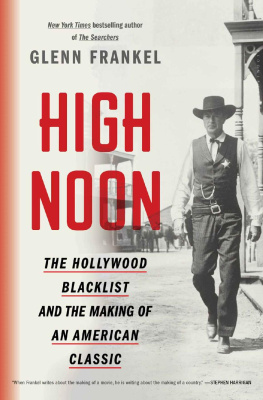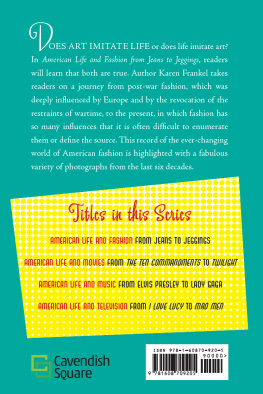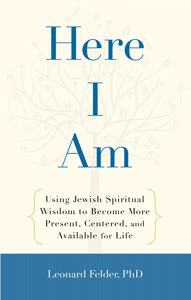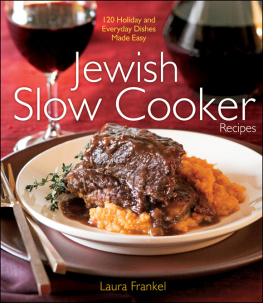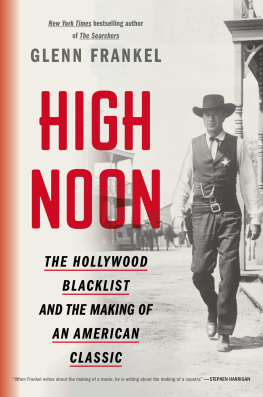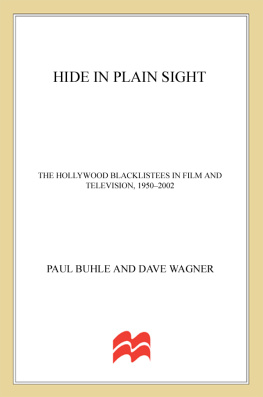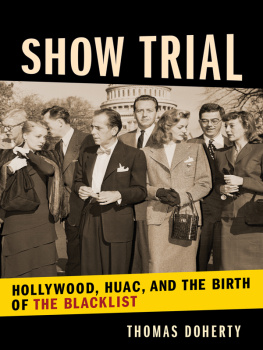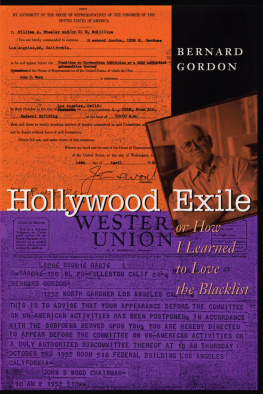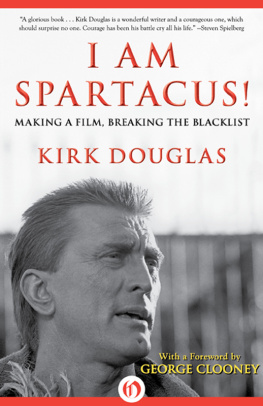Glenn Frankel - High Noon: The Hollywood Blacklist and the Making of an American Classic
Here you can read online Glenn Frankel - High Noon: The Hollywood Blacklist and the Making of an American Classic full text of the book (entire story) in english for free. Download pdf and epub, get meaning, cover and reviews about this ebook. year: 2017, publisher: Bloomsbury Publishing, genre: Non-fiction. Description of the work, (preface) as well as reviews are available. Best literature library LitArk.com created for fans of good reading and offers a wide selection of genres:
Romance novel
Science fiction
Adventure
Detective
Science
History
Home and family
Prose
Art
Politics
Computer
Non-fiction
Religion
Business
Children
Humor
Choose a favorite category and find really read worthwhile books. Enjoy immersion in the world of imagination, feel the emotions of the characters or learn something new for yourself, make an fascinating discovery.
- Book:High Noon: The Hollywood Blacklist and the Making of an American Classic
- Author:
- Publisher:Bloomsbury Publishing
- Genre:
- Year:2017
- Rating:4 / 5
- Favourites:Add to favourites
- Your mark:
- 80
- 1
- 2
- 3
- 4
- 5
High Noon: The Hollywood Blacklist and the Making of an American Classic: summary, description and annotation
We offer to read an annotation, description, summary or preface (depends on what the author of the book "High Noon: The Hollywood Blacklist and the Making of an American Classic" wrote himself). If you haven't found the necessary information about the book — write in the comments, we will try to find it.
Glenn Frankel: author's other books
Who wrote High Noon: The Hollywood Blacklist and the Making of an American Classic? Find out the surname, the name of the author of the book and a list of all author's works by series.
High Noon: The Hollywood Blacklist and the Making of an American Classic — read online for free the complete book (whole text) full work
Below is the text of the book, divided by pages. System saving the place of the last page read, allows you to conveniently read the book "High Noon: The Hollywood Blacklist and the Making of an American Classic" online for free, without having to search again every time where you left off. Put a bookmark, and you can go to the page where you finished reading at any time.
Font size:
Interval:
Bookmark:
To My Parents,
Herbert and Betty Frankel,
With Love and Gratitude
BY THE SAME AUTHOR
The Searchers: The Making of an American Legend
Rivonias Children: Three Families and the Cost of Conscience in White South Africa
Beyond the Promised Land: Jews and Arabs on the Hard Road to a New Israel


United Artists/Photofest
by the kinds of challenges he cannot walk away from.
ARTHUR MILLER
It is one of Hollywoods most iconic images: one man walking down a deserted Western street toward a showdown with four armed killers. For more than sixty years, High Noon, starring Gary Cooper, has embedded itself in our culture and our national memory. Its title itself has become legendary, connoting a moment of truth when a good man must confront evil. It has been beloved by presidents, ordinary moviegoers, and even political movementsmost notably in 1989 when Solidarity used the image as its main campaign poster in Polands first democratic electionas a symbol of courage and determination in the face of overwhelming odds.
Shot in thirty-two days on a shoestring budget, with its famous star working for a fraction of his normal wage, High Noon was something of an afterthought for those who made it, a rush job to fulfill the tail end of an old contract. Yet it vaulted almost immediately to critical acclaim and box-office success. Its taut narrative, powerful performances, evocative theme song, and climactic shootout made it an instant classic. It won four Academy Awards, including best actor for Cooper. Even today it is considered one of the most enduringly popular films of Hollywoods golden age, on a short list with Gone With the Wind, The Wizard of Oz, Casablanca, Citizen Kane, Singin in the Rain, and a handful of others.
Each generation has read into the film its own politics and values. Yet what has largely been forgotten is that High Noons original creator set out with a very specific meaning in mind. In the brief moment of good feeling that followed the Allied victory over Germany and Japan in World War Two, screenwriter Carl Foreman wanted to make a Western about a gang of violent criminals and the lawman who brings them to justice. Inspired by the promise of the newly formed United Nations, it was to be Foremans parable about the need for international law and order to defeat aggression and defend democracy.
But by the time Foreman sat down to write a draft a few years later, the sunny optimism was gone, replaced by a new age of anxiety. The spirit of international cooperation had given way to a Cold War between the United States and the Soviet Union, a brutal conflict on the Korean peninsula, and a nuclear arms race that would last nearly half a century. At home, the progressive coalition that had ruled the United States for more than a decade under President Franklin Roosevelt was unraveling under his successor, Harry Truman. It was challenged by conservatives who had resisted the growth of the federal government in the New Deal era and who now joined forces with embittered working-class populists who felt excluded from their share of prosperity, and self-styled Americanists who believed that outsiders had taken control of the nations civil institutions and culture and were plotting to subvert its security and values. Together they forged a classic backlash movement, as angry and self-righteous as the Tea Party crusaders of the modern era. Usurpersliberals, Jews, and Communists in those days; gays, Muslims, and undocumented immigrants todayhad stolen their country, and the self-appointed guardians of American values were determined to claw it back.
For many Americans, Communism posed an existential threat even more alarming than that posed by Islamic extremists in the modern era. Communists, after all, could be anyoneneighbors, relatives, close friends. They looked and sounded exactly like us, yet they were agents of a ruthless foreign power whose declared goal was to destroy the American way of life. They were the enemy withinthe masters of deceit, in J. Edgar Hoovers chilling characterization.
asked Karl Baarslag, staff member of the National Americanism Commission of the American Legion in 1948. A Communist is a completely transformed, unrecognizable, and dedicated man. While he may retain the physical characteristics of the rest of us as far as natural functions are concerned, his mental and psychic processes might as well be from another planet. A Communist is completely emancipated from all moral inhibitions and is therefore above law, ethics, or morality.
It was not just the far right that spoke of Communists as if they were brainwashed zombies. J. Howard McGrath, attorney general under President Truman, said each Communist Party member carries in himself the germ of death for our society. Adlai Stevenson called Communism combined.
Although exaggerated, these fears were not groundless. The Soviet Union under Joseph Stalin was one of historys most brutal dictatorships, responsible for killing or imprisoning millions. The American Communist Party was a secret political organization that faithfully honored directives from Moscow as if they were commandments, and many members defended the regime even after its crimes were exposed and documented. But most American Communists saw themselves as responding to the inequities and deprivation of the Great Depression by working to create a fairer and more egalitarian society through peaceful means, not violent revolution.
Still, when faced with what they perceive to be an existential threat to their security, Western democracies have often responded by repressing human rights with alarming energy and self-righteous rhetoric, and the early 1950s was no exception. A powerful coalition of investigative agencies, legislative panels, citizens groups, private corporations, and influential journalists banded together to expose and root out the evils of Communism, its true believers, and fellow travelers.
In truth, Hollywood was a mere sideshow in the larger struggle. No atomic secrets were sold or stolen in Beverly Hills. No acts of sabotage or espionage were alleged to have taken place. No large amounts of people or money were involved. But the symbolic power of Hollywood, its extraordinary high profile, and its abiding role in our national culture and fantasies made it an irresistible battleground. The very features that drew the leaders of the American Communist Party to set up shop in Hollywood in the 1930s attracted its antagonists a decade later to come hunt them down.
The House Committee on Un-American Activities was at the vanguard of this crusade. Created a decade earlier, HUAC first held public hearings into alleged Communist infiltration of the motion picture industry in 1947. The sessions had ended in stalemate: eleven current or former Communist Party members had been called to the stand, ten of whom cited the First Amendment in refusing to answer questions about their political affiliations and were charged with contempt of Congress. Civil libertarians condemned the committees methods and actions; even Hollywoods studio heads briefly resisted congressional repression, but ultimately purged the Hollywood Ten from their ranks. Four years later, when the committee returned for a second set of hearings, it faced no meaningful opposition as it issued salmon-pink subpoenas to dozens of actors, screenwriters, and other film workers.
Font size:
Interval:
Bookmark:
Similar books «High Noon: The Hollywood Blacklist and the Making of an American Classic»
Look at similar books to High Noon: The Hollywood Blacklist and the Making of an American Classic. We have selected literature similar in name and meaning in the hope of providing readers with more options to find new, interesting, not yet read works.
Discussion, reviews of the book High Noon: The Hollywood Blacklist and the Making of an American Classic and just readers' own opinions. Leave your comments, write what you think about the work, its meaning or the main characters. Specify what exactly you liked and what you didn't like, and why you think so.

